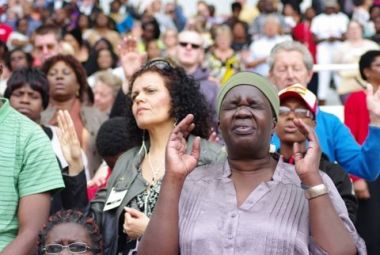Anglican congregations are growing: This is how yours can too

Churches grow by being better at what they do, not by a laser-like focus on numbers, according to a Church of England expert.
It's a perception that has helped to turn the CofE round from sharp decline to a position where on many measures it is actually growing again.
Bob Jackson, a church growth consultant and former Archdeacon of Lichfield, is the author of What Makes Churches Grow? Vision and Practice in Effective Mission. He told Christian Today that the real state of the Church was "hugely different from the narrative in the mainstream media", which was one of inexorable decline, in part because of the challenges of measuring church attendance.
"Traditionally we have measured church attendance by how many turn up at particular worship events. That has got less and less realistic," he says.
Jackson points to changes in patterns of attendance, so that whereas previous generations might have attendance on Sundays every week, modern churchgoers are far less likely to do so. He refers to an "ever-widening gap" between attendance and involvement as people come less often – on average on two out of four Sundays. However, he says, this doesn't equate to decline – and arguably the Church is actually growing.
"The key thing is that the indicator of attendance on an ordinary Sunday is showing a slow decline of about one per cent per annum," he says. However, "There is growth on weekdays, including Fresh Expressions and Messy Church. Add in weekdays and it's probably holding steady."
But that's still not the whole picture, Jackson says. When the number of joiners and the number of leavers – through death or for other reasons – are plotted against each other, the total size of the worshipping community is increasing, because an older person who dies and who attended every week is replaced by a family of four of five who attends once a month.
So, says Jackson, "The average age, which has been going up for a century, has started to fall."
The numbers might be good news, but there are still challenges. "The average strength of adherence is looser and lesser than it used to be," Jackson says. That doesn't mean that these new attenders don't belong, but it does mean that there's work to be done on discipleship – and this is part of an overall understanding of church growth that has profound implications for practitioners.
"My own view is that the Church is growing but that it is not necessarily stronger," says Jackson.
For him, a key question is what we mean by growth, and in the CofE there's an emerging consensus that growth is in three different directions: numerical, spiritual and growth in witness and the Church's impact on the world.
"Healthy churches grow in all directions at once. If you grow in only one, you're deformed." Consequently, "The way to grow numerically is through improving the quality of what you do.
"There used to be professional evangelists. Now, the local church is the only show left in town. The church community is the de facto evangelist. If it's attractive, relevant, vibrant and positive, people will want to be part of it. Make the church better and it will grow."
In his book he urges churches to be intentional about growth, to develop a culture of invitation and welcome, to focus on families – Messy Church has involved 500,000 people in the 11 years since its launch, leading him to describe it in the book as "the biggest single churchgoing growth phenomenon in this country since the rise of Sunday schools and Methodism at the end of the eighteenth century" – and to be prepared for difficult change. One of his ideas – radical for the CofE, though normal in some other denominations – is to lighten the load on priests looking after more than one parish by appointing local lay leaders to take responsibility for individual congregations.
Jackson is upbeat and hopeful about church growth and aware of the difficulties of giving a straightforward "yes" to a question about whether the Church is actually growing. He refers to one of his previous books, Hope for the Church (2002), written at a time when the CofE was declining by every single indicator. "This time, it's only half," he says. "That's a much better position to be in because it means we no longer know whether the Church is declining or not."
However, he says that in spite of a "general climate of hostility and ridicule", people have a higher view of the local church than they do of the national Church. "There will always be people who see through the prevailing narrative and look for something better," he says. And, "Just because the Church is marginalised doesn't mean it will shrink. It might mean the opposite.
"The decline of Christendom and the end of our self-identification as a Christian nation does not mean the decline of the Church. "
What Makes Churches Grow? Vision and Practice in Effective Mission is published by Church House Publishing, price £19.99.











